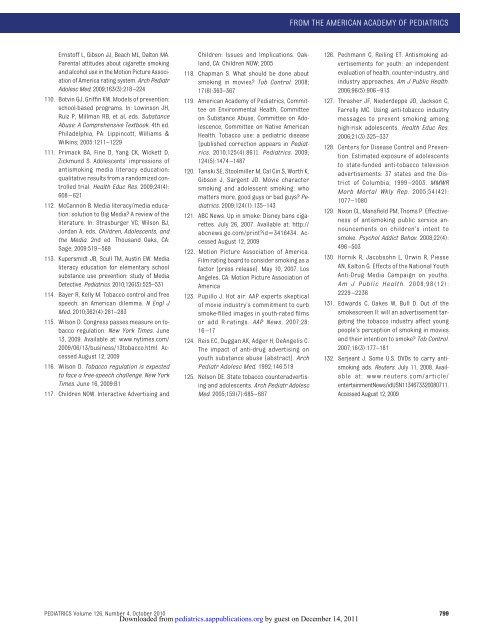Children, Adolescents, Substance Abuse, and the Media
Children, Adolescents, Substance Abuse, and the Media
Children, Adolescents, Substance Abuse, and the Media
You also want an ePaper? Increase the reach of your titles
YUMPU automatically turns print PDFs into web optimized ePapers that Google loves.
FROM THE AMERICAN ACADEMY OF PEDIATRICSErnstoff L, Gibson JJ, Beach ML, Dalton MA.Parental attitudes about cigarette smoking<strong>and</strong> alcohol use in <strong>the</strong> Motion Picture Associationof America rating system. Arch PediatrAdolesc Med. 2009;163(3):218–224110. Botvin GJ, Griffin KW. Models of prevention:school-based programs. In: Lowinson JH,Ruiz P, Millman RB, et al, eds. <strong>Substance</strong><strong>Abuse</strong>: A Comprehensive Textbook. 4th ed.Philadelphia, PA: Lippincott, Williams &Wilkins; 2005:1211–1229111. Primack BA, Fine D, Yang CK, Wickett D,Zickmund S. <strong>Adolescents</strong>’ impressions ofantismoking media literacy education:qualitative results from a r<strong>and</strong>omized controlledtrial. Health Educ Res. 2009;24(4):608–621112. McCannon B. <strong>Media</strong> literacy/media education:solution to Big <strong>Media</strong>? A review of <strong>the</strong>literature. In: Strasburger VC, Wilson BJ,Jordan A, eds. <strong>Children</strong>, <strong>Adolescents</strong>, <strong>and</strong><strong>the</strong> <strong>Media</strong>. 2nd ed. Thous<strong>and</strong> Oaks, CA:Sage; 2009:519–569113. Kupersmidt JB, Scull TM, Austin EW. <strong>Media</strong>literacy education for elementary schoolsubstance use prevention: study of <strong>Media</strong>Detective. Pediatrics. 2010;126(3):525–531114. Bayer R, Kelly M. Tobacco control <strong>and</strong> freespeech: an American dilemma. N Engl JMed. 2010;362(4):281–283115. Wilson D. Congress passes measure on tobaccoregulation. New York Times. June13, 2009. Available at: www.nytimes.com/2009/06/13/business/13tobacco.html. AccessedAugust 12, 2009116. Wilson D. Tobacco regulation is expectedto face a free-speech challenge. New YorkTimes. June 16, 2009:B1117. <strong>Children</strong> NOW. Interactive Advertising <strong>and</strong><strong>Children</strong>: Issues <strong>and</strong> Implications. Oakl<strong>and</strong>,CA: <strong>Children</strong> NOW; 2005118. Chapman S. What should be done aboutsmoking in movies? Tob Control. 2008;17(6):363–367119. American Academy of Pediatrics, Committeeon Environmental Health, Committeeon <strong>Substance</strong> <strong>Abuse</strong>, Committee on Adolescence,Committee on Native AmericanHealth. Tobacco use: a pediatric disease[published correction appears in Pediatrics.2010;125(4):861]. Pediatrics. 2009;124(5):1474–1487120. Tanski SE, Stoolmiller M, Cal Cin S, Worth K,Gibson J, Sargent JD. Movie charactersmoking <strong>and</strong> adolescent smoking: whomatters more, good guys or bad guys? Pediatrics.2009;124(1):135–143121. ABC News. Up in smoke: Disney bans cigarettes.July 26, 2007. Available at: http://abcnews.go.com/print?id3416434. AccessedAugust 12, 2009122. Motion Picture Association of America.Film rating board to consider smoking as afactor [press release]. May 10, 2007. LosAngeles, CA: Motion Picture Association ofAmerica123. Pupillo J. Hot air: AAP experts skepticalof movie industry’s commitment to curbsmoke-filled images in youth-rated filmsor add R-ratings. AAP News. 2007;28:16–17124. Reis EC, Duggan AK, Adger H, DeAngelis C.The impact of anti-drug advertising onyouth substance abuse [abstract]. ArchPediatr Adolesc Med. 1992;146:519125. Nelson DE. State tobacco counteradvertising<strong>and</strong> adolescents. Arch Pediatr AdolescMed. 2005;159(7):685–687126. Pechmann C, Reiling ET. Antismoking advertisementsfor youth: an independentevaluation of health, counter-industry, <strong>and</strong>industry approaches. Am J Public Health.2006;96(5):906–913127. Thrasher JF, Niederdeppe JD, Jackson C,Farrelly MC. Using anti-tobacco industrymessages to prevent smoking amonghigh-risk adolescents. Health Educ Res.2006;21(3):325–337128. Centers for Disease Control <strong>and</strong> Prevention.Estimated exposure of adolescentsto state-funded anti-tobacco televisionadvertisements: 37 states <strong>and</strong> <strong>the</strong> Districtof Columbia, 1999–2003. MMWRMorb Mortal Wkly Rep. 2005;54(42):1077–1080129. Nixon CL, Mansfield PM, Thoms P. Effectivenessof antismoking public service announcementson children’s intent tosmoke. Psychol Addict Behav. 2008;22(4):496–503130. Hornik R, Jacobsohn L, Orwin R, PiesseAN, Kalton G. Effects of <strong>the</strong> National YouthAnti-Drug <strong>Media</strong> Campaign on youths.Am J Public Health. 2008;98(12):2229–2236131. Edwards C, Oakes W, Bull D. Out of <strong>the</strong>smokescreen II: will an advertisement targeting<strong>the</strong> tobacco industry affect youngpeople’s perception of smoking in movies<strong>and</strong> <strong>the</strong>ir intention to smoke? Tob Control.2007;16(3):177–181132. Serjeant J. Some U.S. DVDs to carry antismokingads. Reuters. July 11, 2008. Availableat: www.reuters.com/article/entertainmentNews/idUSN1134673320080711.Accessed August 12, 2009PEDIATRICS Volume 126, Number 4, October 2010 799Downloaded from pediatrics.aappublications.org by guest on December 14, 2011
















